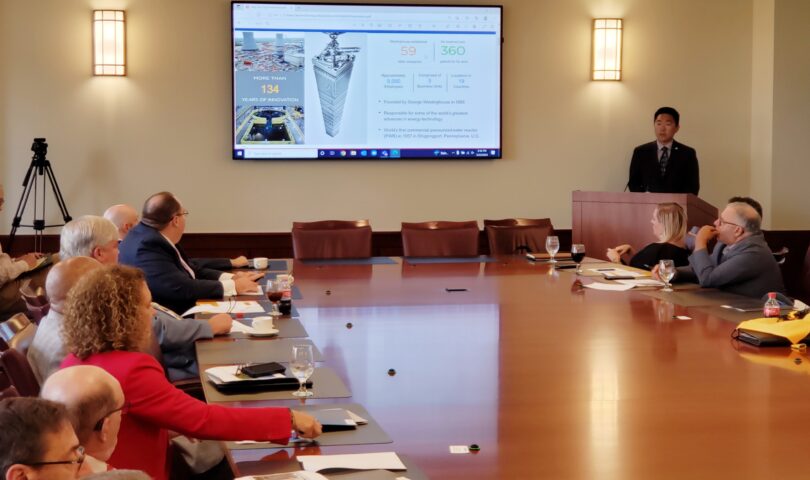MORGANTOWN – In March, the Legislature lifted the statewide ban on construction of nuclear power plants. On Sunday, legislators got a look at what they’ve opened the door for.
Mike Valore, Westinghouse Nuclear senior director for Advanced Reactor Commercialization, explained the eVinci Micro-Reactor – in development at Waltz Mill outside Pittsburgh – to members of the joint Government Operations and Government Organization interim committees.
The Legislature is in Morgantown for May interim meetings.
Micro-reactors, he said, generate less than 10 megawatts of power. The eVinci will put out just over 5 MW, plus 8 MW thermal energy at 350 degrees.
The eVinci, he said, has a smaller footprint and costs far less than a conventional nuclear plant.
The deployment model can be delivered to site in four conventional truck containers. The site will occupy only 1.5 acres while the reactor building is only 60-by-60 feet.
It’s safer in several ways, he said. It’s not cooled by water but contains heat transfer tubes, so the U.S. Department of Energy says its meltdown-proof. The fuel is not rods but TRISO “pebbles” about the size of pool table balls, containing uranium pellets surrounded by layers of protective material.
The eVinci is powered by those, he said. It’s hauled to site fully fueled and will last about eight years. It’s then hauled off site – replaced by another micro-reactor – to Westinghouse which takes care of the spent fuel storage so it doesn’t need to be kept in West Virginia.
There are no pumps, pipes or moving parts. It needs only four to five people to operate, not dozens.
With multiple units, he said, it can be scaled to suit power needs.
Taking questions from legislators, he said it’s not intended to replace conventional power plants. It’s ideal for transporting to remote areas – say Alaska or northern Canada – where grid power is enormously expensive so the power costs for those areas can drop.
For West Virginia, he said, Westinghouse envisions WVU serving as a research hub for the best ways to deploy advanced this type of advanced reactor. Infrastructure and component manufacturing will follow and the ensuing business will build the economy.
“There’s so much potential with this,” he said.
And it will be good for heat, too. “When you talk about zero-carbon, high-temperature heat, there are no options today other than nuclear.”
Nuclear power development typically moves at a glacial pace, and Valore said WVU could have a unit on site comparatively quickly, by the end of 2028. That would give time to build the support infrastructure and supply chain.
Sen. Mike Caputo, D-Marion, asked about security issues. Valore told him that research reactors like this rely on campus police, not a full, armed security force on site. It’s hard to damage or tamper with.
Valore expects a first unit to cost in the $90 million to $120 million range, but as production increases the cost could come down to the $60 million range. Funding for a university unit would be arranged differently than funding for a power plant site in some remote area.
He thinks that setting up small plants in remote areas will have an “immediate positive impact. It’s not something we feel we have to force people to do, its something we feel there is a great need for in many of these areas.”
Tweet David Beard @dbeardtdp Email dbeard@dominionpost.com




